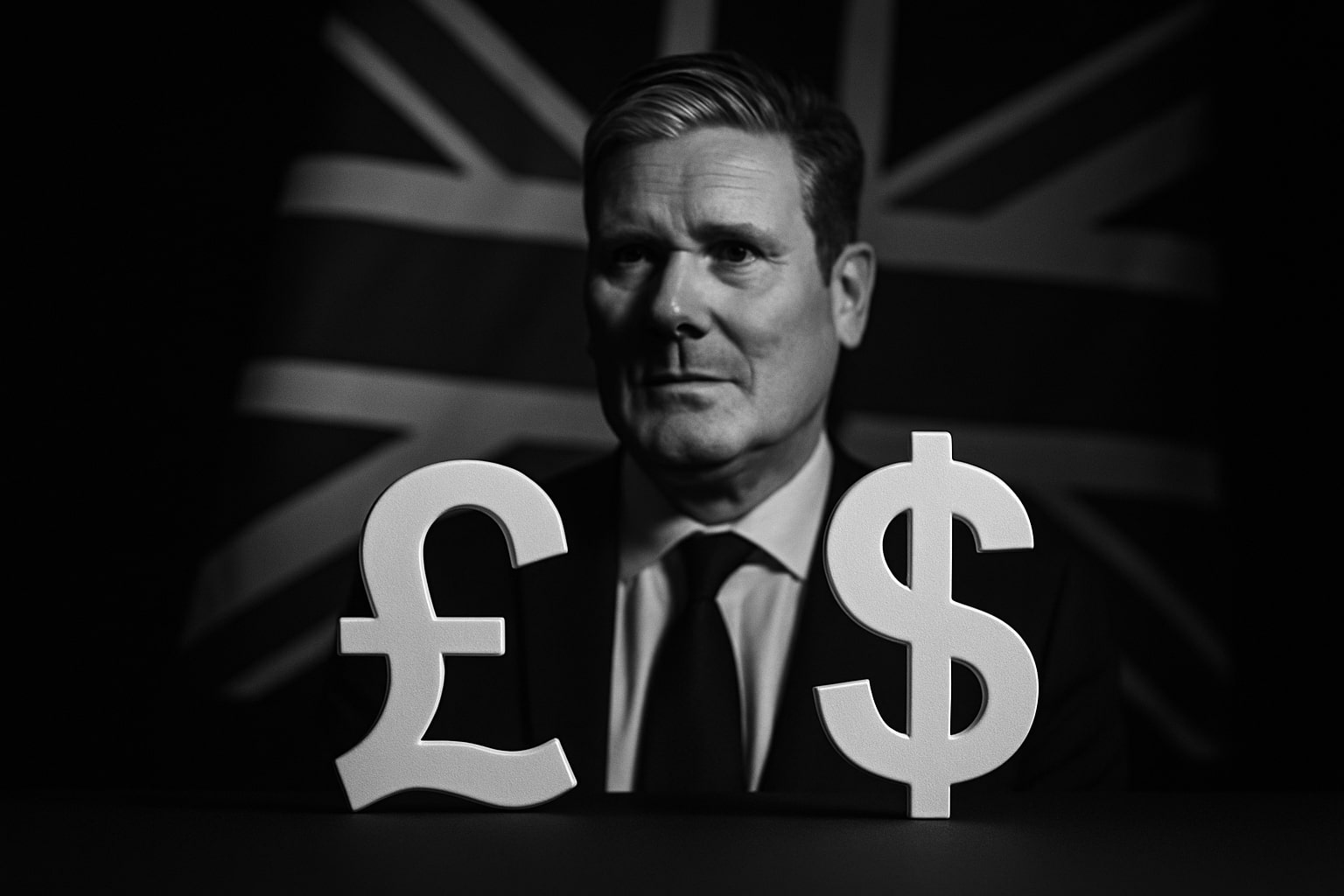
GBP/USD Price Forecast – Pound Drops to $1.3160 as UK Fiscal Crisis, 4.8% Unemployment, and Hawkish Fed Drive Pound to 5-Month Lows
Sterling sinks below the 200-day average to $1.3160 as the UK faces a £30B fiscal gap, stagnant GDP at 0.3%, and inflation stuck at 3.8%, while Powell’s hawkish cut lifts the dollar and traders eye $1.3100 as key support | That's TradingNEWS
GBP/USD Extends Selloff Below 1.3200 as Fiscal Pressures and Fed’s Hawkish Tone Erode Sterling Confidence
The British pound (GBP/USD) trades near 1.3160, marking its third consecutive day of losses after the Federal Reserve’s hawkish rate cut strengthened the dollar. The pair fell 0.35% intraday, breaking decisively below the 200-day simple moving average (SMA) at 1.3237, signaling renewed downside momentum. The selloff underscores investors’ growing skepticism toward the UK’s fiscal outlook, with traders increasingly betting that the Bank of England (BoE) may be forced into a rate cut by December despite still-high inflation.
Fiscal Uncertainty Deepens as UK Faces £30 Billion Budget Gap and Productivity Downgrade
Market sentiment toward sterling deteriorated sharply this week following revelations from the Office for Budget Responsibility (OBR) that UK public finances could suffer a £20 billion hit from weaker productivity projections. Combined with earlier warnings of a £30 billion fiscal shortfall, this represents one of the largest potential budgetary pressures in recent years. Chancellor Rachel Reeves, preparing for her November budget announcement, faces a policy dilemma — uphold campaign pledges not to raise taxes on working households or address the widening deficit. Government borrowing has already overshot estimates by £7.2 billion in the first half of 2025, exacerbating concerns that fiscal tightening will weigh on economic growth. The mounting debt burden and spending constraints have eroded global investor appetite for UK assets, accelerating sterling’s decline against the dollar.
Stubborn Inflation and Weak Growth Trap the Bank of England in Policy Deadlock
The UK inflation rate remained unchanged at 3.8% year-over-year in September, nearly double the BoE’s 2% target, while GDP growth stagnated at just 0.3% in Q2. Unemployment rose to 4.8%, the highest level since mid-2021, reinforcing the perception of a sluggish, fragile economy. Governor Andrew Bailey faces an unenviable dilemma: cutting rates could ease pressure on households but risk reigniting inflation, while maintaining the current 4.00% policy rate could deepen stagnation. Market odds of a December rate cut stand near 74%, reflecting traders’ conviction that monetary easing will soon become unavoidable. The BoE’s upcoming November 6 policy meeting will therefore be pivotal — a hold decision could temporarily stabilize sterling, but an acknowledgment of slowing momentum may extend GBP/USD losses toward new five-month lows.
Pound Slides to Five-Month Lows as Market Confidence Weakens
The recent breach of the 1.3200 handle has intensified bearish momentum, pushing GBP/USD toward its next key support zone around 1.3140, aligning with August’s swing low. The pair’s failure to hold above its 200-day SMA signals a technical breakdown, with traders now eyeing 1.3100 as the next downside target. Intraday recoveries have been shallow, capped repeatedly by resistance at 1.3247–1.3300, indicating persistent selling pressure. Analysts highlight that the British Pound Index (BXY) continues to underperform relative to the U.S. Dollar Index (DXY), which surged following Powell’s comments that another rate cut in December is “not a foregone conclusion.” The hawkish interpretation of the Fed’s decision has magnified transatlantic yield differentials, amplifying dollar dominance and forcing further liquidation of sterling positions.
Fed’s Hawkish Cut and Dollar Strength Amplify Downside Risks for GBP/USD
The Federal Reserve’s 25-basis-point rate cut initially softened the dollar, but Chair Jerome Powell’s insistence on data dependency reversed that sentiment. Powell’s message — that additional cuts are unlikely without clear disinflation evidence — reinforced expectations of higher-for-longer U.S. rates. The U.S. Dollar Index (DXY) rallied back to 99.20, while Treasury yields stabilized above 4.60%, drawing capital away from the pound. The contrast between U.S. fiscal resilience and UK stagnation leaves GBP/USD particularly vulnerable. The divergence also echoes past cycles when fiscal uncertainty in Britain triggered multi-month drawdowns in the currency, with traders recalling parallels to 2019’s budget crisis when cable lost over 6% in three weeks.
Market Technicals Point to Deeper Pullback Toward 1.3100 as Support Weakens
Technically, GBP/USD remains entrenched in a bearish pattern, with daily candles forming lower highs and lower lows. Yesterday’s pin bar reversal on the daily chart underscores renewed seller control, suggesting limited buying interest even near recent lows. Should the pair close decisively below 1.3140, analysts see scope for a test of 1.3100, followed by April’s structural low around 1.3065. Conversely, a rebound above 1.3300 could trigger a short-term corrective move toward 1.3367, coinciding with the 20-day SMA. However, such a recovery would likely be capped by macro fundamentals that favor continued dollar strength. Momentum indicators, including RSI and MACD, remain in bearish territory, reflecting sustained downside pressure.
Read More
-
Eli Lilly Stock Price Forecast - LLY Rises to $843.30 as $17.6B Revenue Beat and GLP-1 Boom Power Strong Buy Signal
30.10.2025 · TradingNEWS ArchiveStocks
-
XRP Price Forecast - XRP-USD Falls to $2.45 Key $2.18–$2.80 Range in Focus, Trump–Xi Trade Deal Trigger Crypto Selloff
30.10.2025 · TradingNEWS ArchiveCrypto
-
Natural Gas Price (NG=F) Steadies at $3.80 as 74 Bcf EIA Build and LNG Demand Set Stage for Winter Rally Toward $4.40
30.10.2025 · TradingNEWS ArchiveCommodities
-
Stock Market Today - Dow Gains 295 Points, Nasdaq Drops 1.12% as Meta Crashes 11% and Eli Lilly Stock (LLY) Surges 4%
30.10.2025 · TradingNEWS ArchiveMarkets
-
EUR/USD Price Forecast - Euro to Dollar Slides to 1.162 as Powell’s Hawkish Fed and Weak Eurozone Data Sink the Euro
30.10.2025 · TradingNEWS ArchiveForex
Labour Market Strain and Rising Unemployment Signal Mounting Domestic Risks
Labour conditions in the UK have softened considerably, with the jobless rate rising to 4.8%, the highest in four years, while wage growth has slowed for three consecutive months. The BoE has acknowledged the deteriorating employment backdrop but remains cautious about overreacting amid still-elevated inflation. The dual pressure of weaker hiring and persistent price growth heightens the risk of stagflation — a scenario increasingly discussed among economists as the country enters a potential fiscal squeeze. Public sentiment mirrors these challenges: surveys show falling confidence among UK households, while consumer spending contracted 0.6% in Q3, the steepest drop since 2022. Such conditions further justify expectations that policymakers may reluctantly pivot toward rate cuts in early 2026.
Dollar Momentum Strengthened by Trade Truce Optimism and U.S. Growth Stability
The pound’s decline also reflects renewed global confidence in the dollar, driven by improved trade stability and better-than-expected U.S. corporate earnings. Positive developments from the Trump–Xi meeting, where both leaders reaffirmed trade cooperation and suspended additional tariffs, bolstered U.S. risk sentiment and the greenback’s appeal. The U.S. economy continues to outperform its peers, with Q3 GDP growing 2.9% annualized and corporate profits rebounding across multiple sectors. In contrast, the UK’s fiscal fragility and subdued growth prospects have widened the performance gap, leading asset managers to favor U.S. holdings over sterling-based investments.
Investor Positioning and Derivative Strategies Reflect Bearish Sentiment
Derivative traders have begun pricing in additional downside protection on GBP/USD. Options data show increased demand for puts at 1.3150 and 1.3100, consistent with expectations for a further slide toward summer lows. Some traders hedge volatility by purchasing short-dated calls above 1.3300, allowing exposure to a potential BoE rebound. Futures markets similarly reflect bearish conviction, with net speculative shorts on sterling rising to a three-month high according to CFTC data. Analysts at TradingNews interpret this as a signal that institutional flows remain decisively risk-off toward GBP assets.
Outlook and Verdict: GBP/USD Bearish Bias – Rating Sell
After weighing fiscal headwinds, monetary constraints, and technical breakdowns, the outlook for GBP/USD remains bearish. Persistent inflation, weakening employment, and fiscal deterioration have undermined investor confidence in the UK’s economic stability. Meanwhile, a resilient U.S. economy and firm dollar liquidity suggest continued downside pressure through November. Unless the Bank of England intervenes with a surprisingly hawkish stance or UK fiscal policy delivers credible reform, cable is likely to test 1.3100 and possibly 1.3060 in the near term. Based on current dynamics, GBP/USD earns a Sell rating, reflecting both macro and technical weakness amid a widening transatlantic divergence.
















